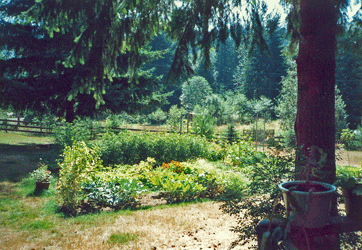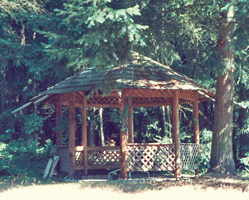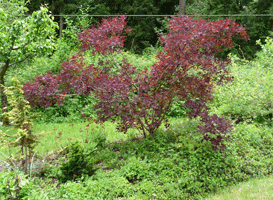- Working with the Devas and Nature Spirits
- Growing Vegetables
- Growing Perennials
- Edible Landscaping
Initially all the plants were selected and all the beds were located with the guidance of the Deva of the Garden.
When we moved in, the area where the main garden is now was a huge lawn with three low burms with rhodies and evergreens out near the property line.

March 1987
First, we planted bare-root fruit trees along the fence line and in an open area towards the back of the property.
Then we hired a landscaper with a rototiller and a sod-lifter to help me create the garden. I lined out 8 beds and a corn patch area and he ran the sod lifter over each bed. We rolled up the sod and then he tried rototilling. The soil was so hard and rocky he couldn't get more than an inch deep. He went home frustrated and I started double digging. By the end of the summer what had been grass now looked like this.

The initial 8 beds that we double dug were meant entirely for growing vegetables. Six of the beds are 16 feet by 4 feet and two of the beds are 16 feet by 5 feet. The length was based on the idea of 4 blocks of 4ft by 4ft. The width provides a distance that can be easily tended from and harvested from either side of the bed. The 5 ft-wide beds were initially created to provide space for a particular trellising system that didn't work out but once they were dug we weren't going to make them narrower. They're still reachable though it's just a bit more work.
All the paths in the main garden are grass. This provides a lovely surface for kneeling and gives the garden a nice look. But it is a royal pain to tend. I do not recommend doing this!

After 2 years of battling to keep the grass from growing into the beds, we installed heavy-duty plastic edging that is 4 inches deep and sunk around the perimeter of each bed. You still have to police the edges to keep the grass out but the edging reins in most of the invasion out. Over the years the grass 'learns' to stay out and forms a rough barrier to growth into the beds.
The second year we began to put the over-all plan for the main garden into action. The main garden forms a circle with the beds around the perimeter all having arched sides to form the circle. The main growing beds were adjusted slightly to provide space for a round center bed.

The inner rectangular beds were dedicated to vegetables and we still use 6 for that purpose. The other two grow flowers now.
The outer beds were initially planted with herbs and flowers and strawberries. While the mix has changed over the years that's still true today. The only major addition is the blueberries that grow amongst the strawberries.
The inner circle initially had herbs in it. We added a paperbark maple (Acer griseum) after about 10 years and the herbs from the center were eventually moved to a new herb burm.
The greenhouse was added in fall 1988. We had to cut down a good-sized Douglas Fir to provide the full sun exposure for it. That also helped provide more sun to the main garden.
That same fall we also added the first of the decks, an octagon deck to shield our cistern and to give a balance to the octagon gazebo on the other side of the garden. This deck is home to my many sun-loving annual pots.

In 1989 we added a hot tub to the gazebo so it has water above ground and the octagon deck has water below ground. Balance!
Meanwhile we also did some work on the burm situation. I removed the sod in the shady area on the kitchen side of the house and dug up and moved all the rhodies that were growing in full sun in the burms.

20 years later all of these are tree-sized and very happy shrubs with hardy cyclamen and bleeding hearts growing beneath them. I had always meant to remove the rest of the grass in that area that struggled in the shade of another big Doug Fir. That finally happened in 2006. That area is now planted in a mix of sedums, sedges and low maintenance perennials.

Initially we added top soil to the original burms and I planted blueberries, gooseberries, currants and perennials. But over time the grass invaded the burms and the perennials got choked out.
In 1998 I began a renovation program for the burms which took nearly 8 years. The goal this time was low maintenance and low water usage since I'd clearly built a garden that was too big for me to tend in it's more high maintenance form.


Since these photos were taken a 2 feet barrier of bark-covered landscape fabric has been added around the edges of the burms to keep the grass out. I run a power edger along that perimeter twice a season in hopes the grass will 'learn' to stay out of these beds for good!
The original corn patch was initially just rototilled since the soil in that area was actually deep enough to be tilled. Then a couple of years later I double dug the area and formed two 4 ft by 16 feet beds with a path down the middle. Here I grew things I wanted to save the seeds of.
Slowly it became a holding area for things I had grown from seed that I wasn't ready to plant out in it's intended final home--renovation projects always take longer than I think! In time, it became a lovely area all of its own.

Near the front door of the house there is a bed that is in deep shade. I struggled for years to find plants that I liked that could thrive there. Finally I've found a mix of epimedium and heurchera and Solomon's seal that seems to have done the trick. In the process of improving the soil for this bed I also managed to revive an old azalea that had been struggling for years!

The design of the Garden at Winterhaven is more a process of finding plants that thrive in the garden than it is of planning a landscape that looks a particular way. My goal is to have happy healthy plants that make my eyes happy and the resonate with the energy of the land.
At this point after 22 years, I feel as if I'm truly beginning to have a balanced AND beautiful garden.
